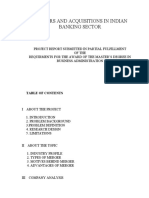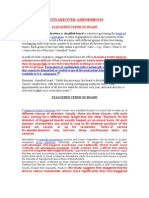Professional Documents
Culture Documents
Economics Updates 2
Economics Updates 2
Uploaded by
Sudip Parajuli0 ratings0% found this document useful (0 votes)
32 views9 pagesThis document discusses mergers and acquisitions (M&A) in the banking sector in Nepal. It provides reasons for mergers such as liquidity issues, capital requirements, and increasing competitiveness in an open financial market. Mergers benefit banks by allowing them to cut expenses, expand into new markets, increase network access for account holders, and prevent insolvency. Examples of mergers in Nepal include the combination of NIC Bank and BOAN to form NIC Asia Bank, and the merger of Global Bank, IME Financial Institution, and Lord Buddha Finance to create Global IME Bank.
Original Description:
hgtt
Copyright
© © All Rights Reserved
Available Formats
PPTX, PDF, TXT or read online from Scribd
Share this document
Did you find this document useful?
Is this content inappropriate?
Report this DocumentThis document discusses mergers and acquisitions (M&A) in the banking sector in Nepal. It provides reasons for mergers such as liquidity issues, capital requirements, and increasing competitiveness in an open financial market. Mergers benefit banks by allowing them to cut expenses, expand into new markets, increase network access for account holders, and prevent insolvency. Examples of mergers in Nepal include the combination of NIC Bank and BOAN to form NIC Asia Bank, and the merger of Global Bank, IME Financial Institution, and Lord Buddha Finance to create Global IME Bank.
Copyright:
© All Rights Reserved
Available Formats
Download as PPTX, PDF, TXT or read online from Scribd
Download as pptx, pdf, or txt
0 ratings0% found this document useful (0 votes)
32 views9 pagesEconomics Updates 2
Economics Updates 2
Uploaded by
Sudip ParajuliThis document discusses mergers and acquisitions (M&A) in the banking sector in Nepal. It provides reasons for mergers such as liquidity issues, capital requirements, and increasing competitiveness in an open financial market. Mergers benefit banks by allowing them to cut expenses, expand into new markets, increase network access for account holders, and prevent insolvency. Examples of mergers in Nepal include the combination of NIC Bank and BOAN to form NIC Asia Bank, and the merger of Global Bank, IME Financial Institution, and Lord Buddha Finance to create Global IME Bank.
Copyright:
© All Rights Reserved
Available Formats
Download as PPTX, PDF, TXT or read online from Scribd
Download as pptx, pdf, or txt
You are on page 1of 9
GROUP -ORGANI SER
Mergers and Acquisitions
Reasons behind merging
Benefits of merger
Examples of merger
Presentation by
1) Sneha Karki
2) Sudip Rimal
3) Pawan Raj Lohani
4) Sanjeet Dahal
5) Gudiya Shah
Mergers and Acquisitions (abbreviated M&A) refers to the aspect of corporate
strategy, corporate finance and management dealing with the buying, selling,
dividing and combining of different companies .
similar entities that can aid, finance, or help an enterprise grow rapidly in its
sector or location of origin or a new field or new location without creating a
subsidiary, other child entity or using a joint venture.
Mergers and Acquisitions
Liquidity Crunch:
Liquidity refers to the amount of money in the form of cash. The amounts of
deposits in bank are very low and the rate of loan recovery rate is also very
low. Hence, M&A is believed to solve the liquidity problem as the deposits of
the two banking institutions are combined as one.
Capital requirement:
The paid-up capital requirement of the Nepalese bank is currently Rs. 2 Billion.
However, the government is planning to raise the paid-up capital requirement
from 2 Billion to 5 Billion.
Reasons behind merging
Continued
Open Financial Market:
It concerns about the capacity of local banks to compete with its foreign
counterparts. Hence, M&A will minimize costs, increase the economies of scale,
and increase institution's capacity, thus being able to compete at international
level.
(As Published on October 2012 Issue of BOSS- A monthly business magazine
of Nepal)
BENEFI TS OF MERGI NG
Bank mergers bring benefits to banking entities, shareholders, employees and
account holders. Banks that merge can cut expenses, and this enables banks to pass
on those savings to account holders in the form of lower-priced products.
Expansion
To expand into a new market, a bank can either buy real estate, build
banks, train employees and pay advertising costs, or it can merge with
another banks.
Expenses
When two banks merge, the new entity can cut costs in a number of
different ways. The combined entities save money overall by eliminating
one set of each internal department after the merger.
Continued
Network
Account holders benefit from bank mergers because they have access to a wider
network of branches and automated-teller machines.
I nsolvency
When banks become insolvent, account holders' deposits are only federally insured
for up to $250,000 per account. Additionally, when a bank goes bankrupt, the
shareholders lose their investment and employees lose their jobs. The Federal
Deposit Insurance Corporation attempts to broker mergers between strong and
banks before the failing bank goes bankrupt.
EXAMPLES OF MERGER
NI C-ASI A Bank has emerged as the first bank to commence its operation
after completing its merger as per the schedule proposed by both the banks.
Merger is not easy. One must realize that a bank is not like a cement
factory or other establishment and the merger should not be taken as a way
to evade taxes or other such things," said Governor Dr. Khaitwada,
inaugurating the corporate office.
Before the merger, NIC Bank had 36 branches and BOAN 29 branches.
With the consolidation of 13 branches and addition of a Corporate Branch,
NIC Asia Bank now have 53 branches and 57 ATMs which will be expanded
to a total of 66 branches within 1 year with the re-location of the 13
branches.
Continued
Global I ME Bank Ltd. emerged after successful merger of Global Bank
Ltd (an A class commercial bank), IME Financial Institution (a C class
finance company) and Lord Buddha Finance Ltd. (a C class finance company)in
year 2012. Two more development banks (Social Development Bank and Gulmi
Bikas Bank) merged with Global IME Bank Ltd in year 2013.
Thank You
You might also like
- Merger of Banks - BLACK BOOK 158Document56 pagesMerger of Banks - BLACK BOOK 158AJ-ay SH-ah100% (5)
- Project Report On Merger of BanksDocument118 pagesProject Report On Merger of Banksbirendra100% (1)
- Mergers and Acquisitions in Indian Banking SectorDocument118 pagesMergers and Acquisitions in Indian Banking SectorAishwarya AwateNo ratings yet
- Mergers and Acquisitions in Indian Banking SectorDocument98 pagesMergers and Acquisitions in Indian Banking Sectorzeeshana7871% (7)
- Accounting Business Combinations Nci PDFDocument794 pagesAccounting Business Combinations Nci PDFShahzad Pirvani100% (1)
- Oil & Gas Co. Addresses (Pakistan)Document33 pagesOil & Gas Co. Addresses (Pakistan)Üsa Ma79% (19)
- Chedaka AgroDocument1 pageChedaka AgroJohn Walter Torre100% (1)
- Millegan CreekDocument4 pagesMillegan Creekashwinmkumar25% (4)
- 11-Higher Highs & Lower LowsDocument6 pages11-Higher Highs & Lower LowsEmanuel Maracajá100% (2)
- Chapter-I: 1.1 Background of The StudyDocument61 pagesChapter-I: 1.1 Background of The StudyPratikshya Karki100% (1)
- 1.1 Background of The StudyDocument4 pages1.1 Background of The StudyPratikshya KarkiNo ratings yet
- Research Paper On Merger and Acquisition in Banking Sector in IndiaDocument8 pagesResearch Paper On Merger and Acquisition in Banking Sector in Indiahydip1k1vif3No ratings yet
- Kuch Toh HaiDocument21 pagesKuch Toh HaiMihirParmarNo ratings yet
- UntitledDocument52 pagesUntitledHarshpreet Kaur 20204No ratings yet
- Case Study On Meregers & Acquisition of Banks - Shaikh Sahil (6215)Document15 pagesCase Study On Meregers & Acquisition of Banks - Shaikh Sahil (6215)S4 InsaneNo ratings yet
- Universal BankingDocument13 pagesUniversal BankingShrutikaKadamNo ratings yet
- BlackDocument14 pagesBlackpriya tiwariNo ratings yet
- Anu ThesisDocument62 pagesAnu ThesisRoman NepalNo ratings yet
- Pre Merger and Post Merger Financial Analysis of Indian BankDocument12 pagesPre Merger and Post Merger Financial Analysis of Indian BankKRISHNA PRASAD SAMUDRALANo ratings yet
- Loan Services of Trust BankDocument19 pagesLoan Services of Trust BankMd. Shahnewaz KhanNo ratings yet
- Bank Consolidation Key Reasons For MergerDocument2 pagesBank Consolidation Key Reasons For MergerParth AggarwalNo ratings yet
- Vol 1 Iss 1 Paradise Infocreative Project Developing CenterDocument22 pagesVol 1 Iss 1 Paradise Infocreative Project Developing Centerannie steffi sydneyNo ratings yet
- Comparative Analysis Between Islami Bank Bangladesh Limited and Jamuna Bank Limite1Document42 pagesComparative Analysis Between Islami Bank Bangladesh Limited and Jamuna Bank Limite1Tahsin Monabil0% (1)
- Sujan Raj Bhattarai Final Proposal Global IME - Draft - Rev - 2Document11 pagesSujan Raj Bhattarai Final Proposal Global IME - Draft - Rev - 2Pradip Kumar ShahNo ratings yet
- Introduction To The CompanyDocument28 pagesIntroduction To The CompanyMukesh ManwaniNo ratings yet
- Co Op Bank Business PlanDocument4 pagesCo Op Bank Business PlanltsxnybieNo ratings yet
- BASIC Bank Full ReviewDocument6 pagesBASIC Bank Full ReviewJonaed Ashek Md. RobinNo ratings yet
- Research Papers On Cooperative Banking in IndiaDocument6 pagesResearch Papers On Cooperative Banking in Indiaovkpwsgkf100% (1)
- Commerical Banking JUNE 2022Document11 pagesCommerical Banking JUNE 2022Rajni KumariNo ratings yet
- AmalgamationDocument50 pagesAmalgamationNikesh KothariNo ratings yet
- Consolidation Through M&A: - Sector - Needs - Consolidation - HTMLDocument8 pagesConsolidation Through M&A: - Sector - Needs - Consolidation - HTMLprachi jainNo ratings yet
- EBL Internship ReportDocument59 pagesEBL Internship ReportRiyad AhsanNo ratings yet
- Credit Management Mid Term Assignment - Arafat Hussain - Id - 1303010034Document12 pagesCredit Management Mid Term Assignment - Arafat Hussain - Id - 1303010034ArafatAdilNo ratings yet
- Recent Developments in Merger of Nationalized Banks-Motives, Advantages and DisadvantagesDocument6 pagesRecent Developments in Merger of Nationalized Banks-Motives, Advantages and Disadvantagesvijayadarshini vNo ratings yet
- A Study Report On Bank MergerDocument3 pagesA Study Report On Bank MergerAshish kumar ThapaNo ratings yet
- Bank MergerDocument3 pagesBank MergerAshish kumar ThapaNo ratings yet
- Spoorthi V Full Report Editing FinalDocument72 pagesSpoorthi V Full Report Editing Finalspoorthi venuNo ratings yet
- Spellchecked - Mba - Project - Mergers and AquisitionsDocument107 pagesSpellchecked - Mba - Project - Mergers and AquisitionsDanturthi RamachandruduNo ratings yet
- Bank & BankingDocument6 pagesBank & BankingSourav BhattacharjeeNo ratings yet
- PMC ScamDocument15 pagesPMC ScamAkansha Biswas62% (13)
- ChapterDocument88 pagesChaptersahilbastola1No ratings yet
- Post Merger Analysis of Sbi and It'S Associate Banks On Customer'S PerceptionDocument4 pagesPost Merger Analysis of Sbi and It'S Associate Banks On Customer'S PerceptionLucky khandelwalNo ratings yet
- Ific BankDocument95 pagesIfic BankAl AminNo ratings yet
- Consolidation & Mergers in BankingDocument7 pagesConsolidation & Mergers in BankingISHAN CHAUDHARYNo ratings yet
- Commercial Bank ManagementDocument22 pagesCommercial Bank ManagementAsif HossainNo ratings yet
- Bad Bank - A Good Initiative ? Challenges and AdvantagesDocument6 pagesBad Bank - A Good Initiative ? Challenges and AdvantagesVISHWANATH SAGAR S 18CBCOM105No ratings yet
- Mergers and Acquisitions of BanksDocument9 pagesMergers and Acquisitions of Banksneha s nairNo ratings yet
- Black Book ProjectDocument17 pagesBlack Book ProjectRuksar QureshiNo ratings yet
- Indian Economy Research PaperDocument7 pagesIndian Economy Research PaperShruti BindalNo ratings yet
- Report Submission Finance (Noboni)Document20 pagesReport Submission Finance (Noboni)Afrid KhanNo ratings yet
- Analysis - DBBL & MTBLDocument32 pagesAnalysis - DBBL & MTBLsalmanzaki12No ratings yet
- Black Book ProjectDocument18 pagesBlack Book ProjectRuksar QureshiNo ratings yet
- Financing Small and Medium Business Enterprises by Janata Bank LTDDocument74 pagesFinancing Small and Medium Business Enterprises by Janata Bank LTDShowkatul IslamNo ratings yet
- SME Banking of NCCBLDocument51 pagesSME Banking of NCCBLFahim ShafiNo ratings yet
- Summit BankDocument53 pagesSummit BankJaved Iqbal50% (2)
- PAPER Analysis of Non-Performing Asset On Urban Cooperative Bank in IndiaDocument11 pagesPAPER Analysis of Non-Performing Asset On Urban Cooperative Bank in IndiaDr Bhadrappa HaralayyaNo ratings yet
- Thesis On Urban Cooperative BanksDocument6 pagesThesis On Urban Cooperative Bankssararousesyracuse100% (2)
- Banking System in IndiaDocument9 pagesBanking System in IndiaBhavesh LimaniNo ratings yet
- The End of Development FinanceDocument5 pagesThe End of Development FinanceravichandrankkNo ratings yet
- Case Study GroupDocument9 pagesCase Study GroupPrabhujot SinghNo ratings yet
- T R A N S F O R M A T I O N: THREE DECADES OF INDIA’S FINANCIAL AND BANKING SECTOR REFORMS (1991–2021)From EverandT R A N S F O R M A T I O N: THREE DECADES OF INDIA’S FINANCIAL AND BANKING SECTOR REFORMS (1991–2021)No ratings yet
- The Bankable SOE: Commercial Financing for State-Owned EnterprisesFrom EverandThe Bankable SOE: Commercial Financing for State-Owned EnterprisesNo ratings yet
- Banking India: Accepting Deposits for the Purpose of LendingFrom EverandBanking India: Accepting Deposits for the Purpose of LendingNo ratings yet
- Public Financing for Small and Medium-Sized Enterprises: The Cases of the Republic of Korea and the United StatesFrom EverandPublic Financing for Small and Medium-Sized Enterprises: The Cases of the Republic of Korea and the United StatesNo ratings yet
- Human Resource Management Sub: Application For Management TraineeDocument1 pageHuman Resource Management Sub: Application For Management TraineeSudip ParajuliNo ratings yet
- Thesis 1Document50 pagesThesis 1Sudip ParajuliNo ratings yet
- SM Unit2Document20 pagesSM Unit2Sudip ParajuliNo ratings yet
- BC Internship Application FormDocument3 pagesBC Internship Application FormSudip ParajuliNo ratings yet
- Sales & Distribution MGMT SyllabusDocument3 pagesSales & Distribution MGMT SyllabusSudip ParajuliNo ratings yet
- List of Commercial BanksDocument1 pageList of Commercial BanksSudip ParajuliNo ratings yet
- Factories Act, 1948Document13 pagesFactories Act, 1948Sudip ParajuliNo ratings yet
- Able of OntentsDocument6 pagesAble of OntentsSudip ParajuliNo ratings yet
- Application LetterDocument1 pageApplication LetterSudip ParajuliNo ratings yet
- Logical Process ModelDocument6 pagesLogical Process ModelSudip ParajuliNo ratings yet
- Filters Only ListDocument2 pagesFilters Only ListThane MasureikNo ratings yet
- The Manufacturer To The CustomerDocument2 pagesThe Manufacturer To The CustomerromaNo ratings yet
- Aoi Walang ForeverDocument6 pagesAoi Walang ForeverJuris PoetNo ratings yet
- Mimi Case 1191Document5 pagesMimi Case 1191DWNo ratings yet
- Willingdon College, Sangli. Willingdon College, Sangli. Willingdon College, Sangli. Willingdon College, SangliDocument2 pagesWillingdon College, Sangli. Willingdon College, Sangli. Willingdon College, Sangli. Willingdon College, SangliTik tok & Funny videoNo ratings yet
- Marketing Maggi Case PDFDocument4 pagesMarketing Maggi Case PDFAmarnath DixitNo ratings yet
- Miravite Table of ContentsDocument5 pagesMiravite Table of ContentsjoahnabulanadiNo ratings yet
- BA5014-Entrepreneurship Development PDFDocument12 pagesBA5014-Entrepreneurship Development PDFJanakakumariNo ratings yet
- SolutionDocument12 pagesSolutionFais Rock0% (2)
- 大潭電廠GE風力發電機組儀電維護技術實習Document46 pages大潭電廠GE風力發電機組儀電維護技術實習double linNo ratings yet
- 75 Years of IndependenceDocument43 pages75 Years of IndependenceNeeraj VermaNo ratings yet
- Millward Brown: WPP (Wire and Plastic Products)Document2 pagesMillward Brown: WPP (Wire and Plastic Products)kurtdias1No ratings yet
- Money Laundering and Tax Evasion and Acceding CountriesDocument23 pagesMoney Laundering and Tax Evasion and Acceding Countries11111No ratings yet
- Anti Takeover DefenceDocument7 pagesAnti Takeover DefenceDarryl LimNo ratings yet
- Indian Banking Industry: An AnalysisDocument30 pagesIndian Banking Industry: An AnalysisfecaxeyivuNo ratings yet
- Problem CH 7 Hansen Mowen Cornerstone of Managerial AccountingDocument8 pagesProblem CH 7 Hansen Mowen Cornerstone of Managerial Accountingwiwit_karyantiNo ratings yet
- Internet Mini Case 8 Southwest AirlinesDocument5 pagesInternet Mini Case 8 Southwest AirlinesAhyar AjaNo ratings yet
- (254306109) SSRN-id2352489Document22 pages(254306109) SSRN-id2352489Anirudh AroraNo ratings yet
- Growth in Banking SectorDocument30 pagesGrowth in Banking SectorHarish Rawal Harish RawalNo ratings yet
- Chap8 PDFDocument63 pagesChap8 PDFFathinus SyafrizalNo ratings yet
- SIP ReportDocument111 pagesSIP ReportDesarollo OrganizacionalNo ratings yet
- GlobalisationDocument7 pagesGlobalisationAnjali MishraNo ratings yet
- Electrolux Report Final TotalDocument128 pagesElectrolux Report Final TotalAnonymous H0SJWZE8No ratings yet
- Lombra ReportDocument2 pagesLombra ReportOswalt PattonNo ratings yet
- Pafr Reviewer 1Document8 pagesPafr Reviewer 1DEAN JASPERNo ratings yet



































































































